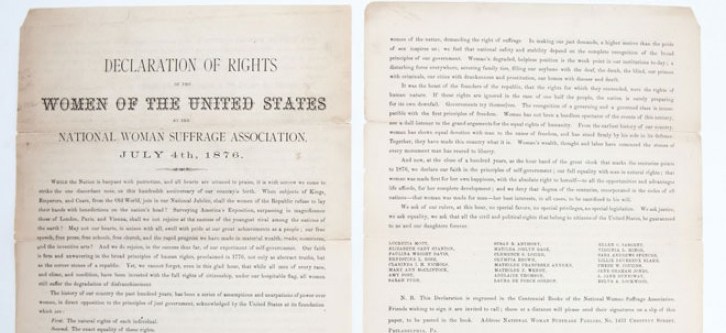Feast your eyes on some of the rare books and related items that will be available exclusively at the ABAA Virtual Book Fair: New York Edition, September 9-12, 2021. The dealers offering these items will be identified after the fair opens!
The Garden Murder Case: A Philo Vance Story
Van Dine, S. S. [PSEUD Willard Huntington Wright (1888-1939)] inscribed
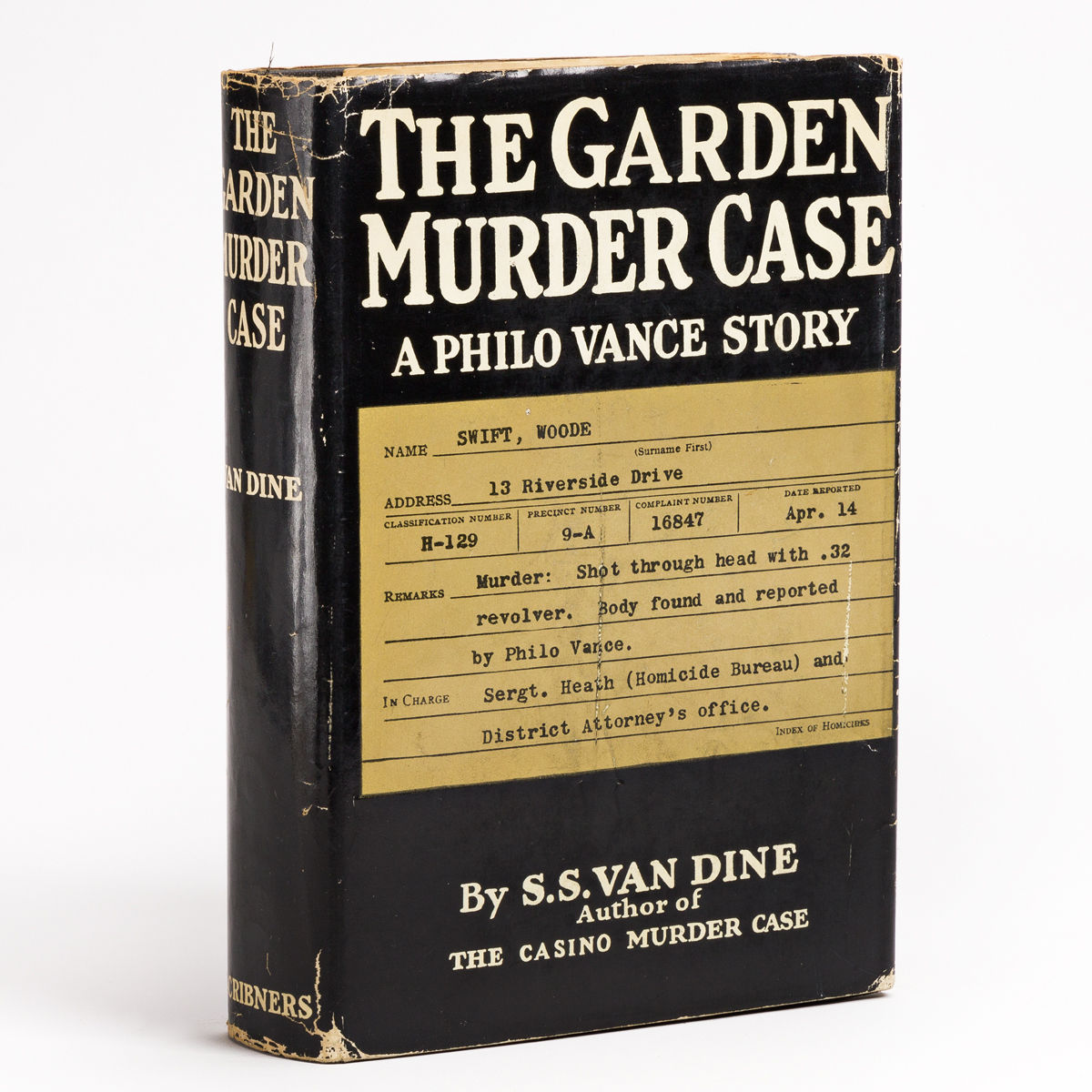
332+[viii ad] pages. Small octavo (7 1/2" x 5 1/2") bound in original publisher's gilt-stamped black cloth in original jacket. Inscription to front end paper. (Firsts Volume 14, number 9 page 31) First edition.
Garden marked the return to the original design for the dust wrappers, without any graphics added to the standard index card layout. Here the card is in gold and the front and back panels, and the front and spine of the book's cover are also stamped in gold. Floyd, the son of Professor Garden, invites his socialite friends to the rooftop garden of his father's New York penthouse to listen to the outcome of horse races. Detective Philo Vance receives an anonymous telephone message inviting him to one of Floyd's gatherings. On that particular night, Floyd's best friend has placed an enormous bet on a horse named Equanimity. Once it is announced that Equanimity has lost the race, a gunshot is heard and Floyd's friend is found dead of a gunshot wound. Though initially thought to be a suicide, Detective Vance deems the death a murder. The night proves to be even more eventful, due to the attempted poisoning of Floyd's mother's nurse and the subsequent murder of his mother. Ultimately, Detective Vance is able to solve the murders. He lures the murderer into revealing himself and gathers photographic evidence of him trying to push the detective off of the garden balcony.
Condition: Inscribed on front end paper "To / Harry P. Burton / With sincerest regards / S.S. Van Dine.". Irregular darkening to lower outer blank margins of front end end matter, gently bumped corners. Jacket edgewear, heaviest to flap folds, fold corners, and head and foot of spine panel, unclipped else better than very good in like jacket.
Offered by The Book Collector.
The Pennsylvania Magazine: or American Monthly Museum. For July, 1775.
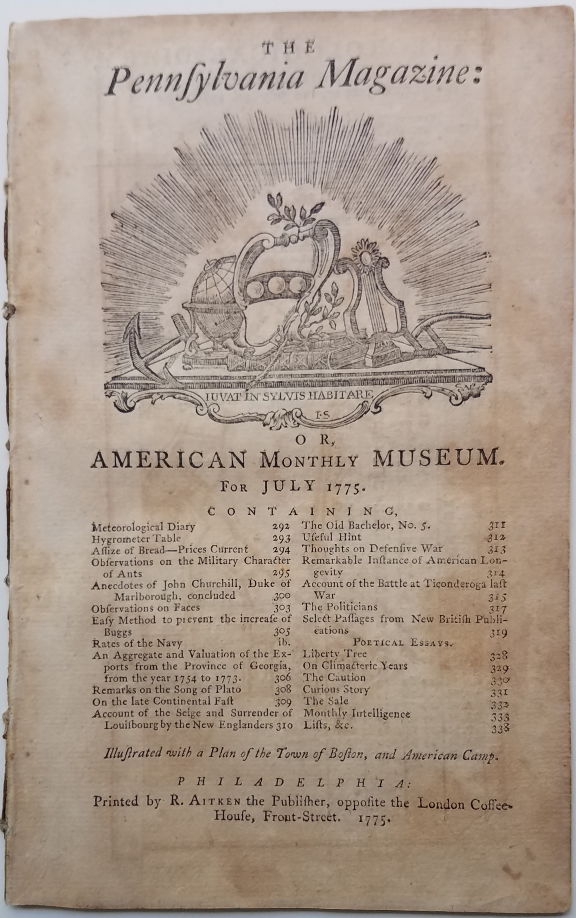
The first issue of The Pennsylvania Magazine was for January, 1775; the last for July, 1776. This is the July, 1775 issue, a month after the battle at Bunker Hill. It contains a complete, contemporary printing of one of the nation's foundation documents -- the "Declaration...setting forth the Causes and Necessity of... taking up Arms." That Declaration of the second Continental Congress, dated July 6, 1775 and signed by John Hancock, justified the armed resistance the colonists were compelled to undertake against Britain.
Written by John Dickinson and Thomas Jefferson (in an unhappy collaboration), the Declaration enumerated multiple grievances against their mother country, including taxation without representation, the quartering of troops, attacks upon the judicial system, and so on. Although this Declaration specifically denied an interest in separation from Great Britain, many of the same themes would be laid out again just one year later in the Declaration of Independence. The "Causes and Necessities" was a decisive milepost on the Colonies' path to independence.
The Pennsylvania Magazine was the only magazine being printed in America at this time, since Boston's Royal American Magazine had expired with its March, 1775 issue. Thus this was the only contemporary magazine printing of "the Causes and Necessities." Thomas Paine was editor of the Magazine for much of its 19-month run, including for this issue.
Contemporary printings of "the Causes and Necessities" appear as separately issued pamphlets, in newspapers and in this sole magazine format. The separate issues and newspaper appearances generally sell in the $25,000 to $35,000 range. A July 21-27, 1775 Massachusetts newspaper printing of the Declaration was offered by a prominent dealer for $35,000 (and was sold). The example offered here in the July, 1775 issue of The Pennsylvania Magazine has the added advantage of being an imprint from Philadelphia, the site of the Continental Congress.
In addition to the "Causes and Necessities," this issue also includes the important map, A New and Correct Plan of the Town of Boston and Provincial Camp. It is among the earliest American-printed maps to depict the military aspects of the siege of Boston, including various forts, batteries, main guard, provincial lines, Gage's lines, etc. The Liberty T[ree] is also shown near the end of Frog Lane.
Finally, this issue of the Magazine includes the first printing of Thomas Paine's "Liberty Tree Song," a popular patriotic song of the American Revolution.
Historic content and a wonderful map in an important Revolutionary War magazine.
Mott, History of American Magazines 1741-1850: pp. 87-91. Richardson, History of Early American Magazines, 1741-1789: pp. 174-196. For the map: Nebenzahl: Bibliography of the Printed Battle Plans of the American Revolution, 1775-1795: 2. [ICN 3566.]
Offered by Bickerstaff's Books & Maps.
The Compleat Auctioneer, the EARLIEST IMAGE OF A BOOK AUCTION broadside, circa 1700.
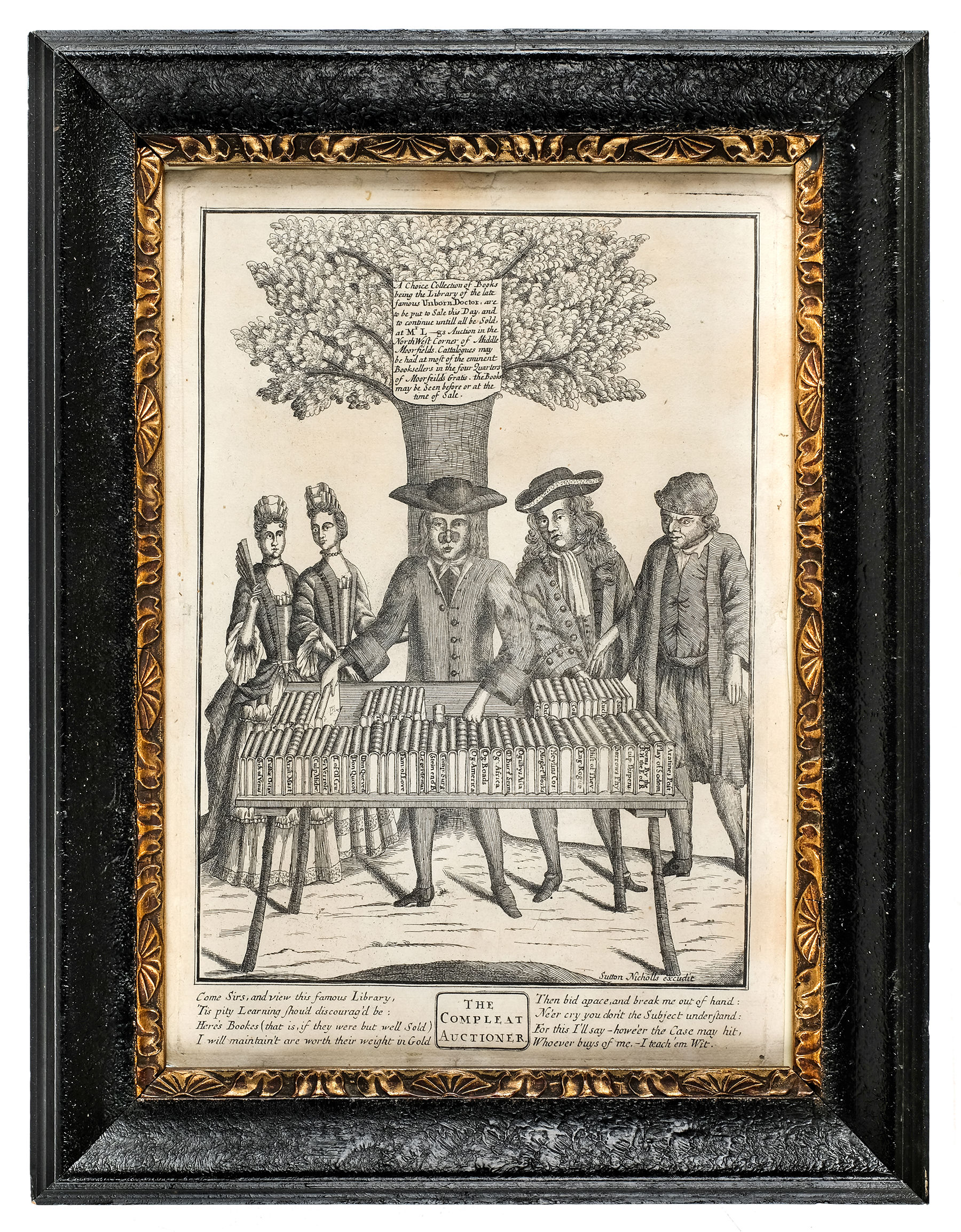
The Compleat Auctioneer, circa 1700, uncolored engraving of a book auctioneer standing behind a stall of books, with two ladies and two gentlemen beside him, and a tree behind, the tree bearing a printed notice 'A Choice Collection of Books being the Library of the late famous Unborn Doctor, are to be put to Sale this Day and to continue untill all be Sold, at Mr L-GS Auction in the North West Corner of Middle Moorfields. Cattalogues may be had at most of the eminent Booksellers in the four Quarters of Moorfeilds Gratis, the Books may be Seen before or at the time of Sale', the whole set within a 19th century black and gilt moulded frame, glazed.
Rare. The earliest known representation of a book auction. The table of books on display include many bawdy titles of the restoration era, such as 'Sch: of Venus', 'Aratines Post.', 'Play of Sodom', 'Poems by the R H the E[arl] of R[ochester], alongside standard medical works of the period, 'Culp Midw', 'Artist[otles] Mast[erpiece]', and other various titles including 'Don Quixot', 'Og[ilby] America' (also his Roads Africa and Asia), 'Heylins Cos[mography]'. Below the image is printed 8 lines of verse: 'Come Sirs, and view this famous Library, 'Tis pity Learning shou'd discourag'd be: Here's bookes (that is, if they were but well Sold) I will maintain't are worth their weight in Gold Then bid apace and break me out of hand: Ne'er cry you don't the Subject understand: For this I'll say - howe'er the Case may hit, Whoever buys of me, - I teach 'em Wit.'
Book auctions first became popular in the Low Countries, where Lodewijk Elzevier was granted permission to hold them in The Hague in 1596. The first recorded book auction in England was held in London in 1676, when the library of the clergyman Lazarus Seaman was put up for sale at his own house. This print, however, is the very first pictorial representation of a book auction. Its engraver Sutton Nicholls was a printseller, draughtsman and globemaker who worked for various map publishers: Philip Lea, Robert Morden, Edward Wells, Henry Overton, Thomas and John Bowles, &c.
British Museum, Personal and Political Satires 1415. Provenance: Library of Martin Orskey (Dominic Winter, June 2019) = Sold for £18,500 hammer + premium and internet fees (approx. US$30,000).
Offered by Battledore, Ltd.
Official NASA Photograph of Buzz Aldrin on the Moon's Surface Signed By All Three Astronatuts of Apollo 11, with Official Patch, and U.S. Consul Gordon Bell's role in Their Visit to Australia, 1969
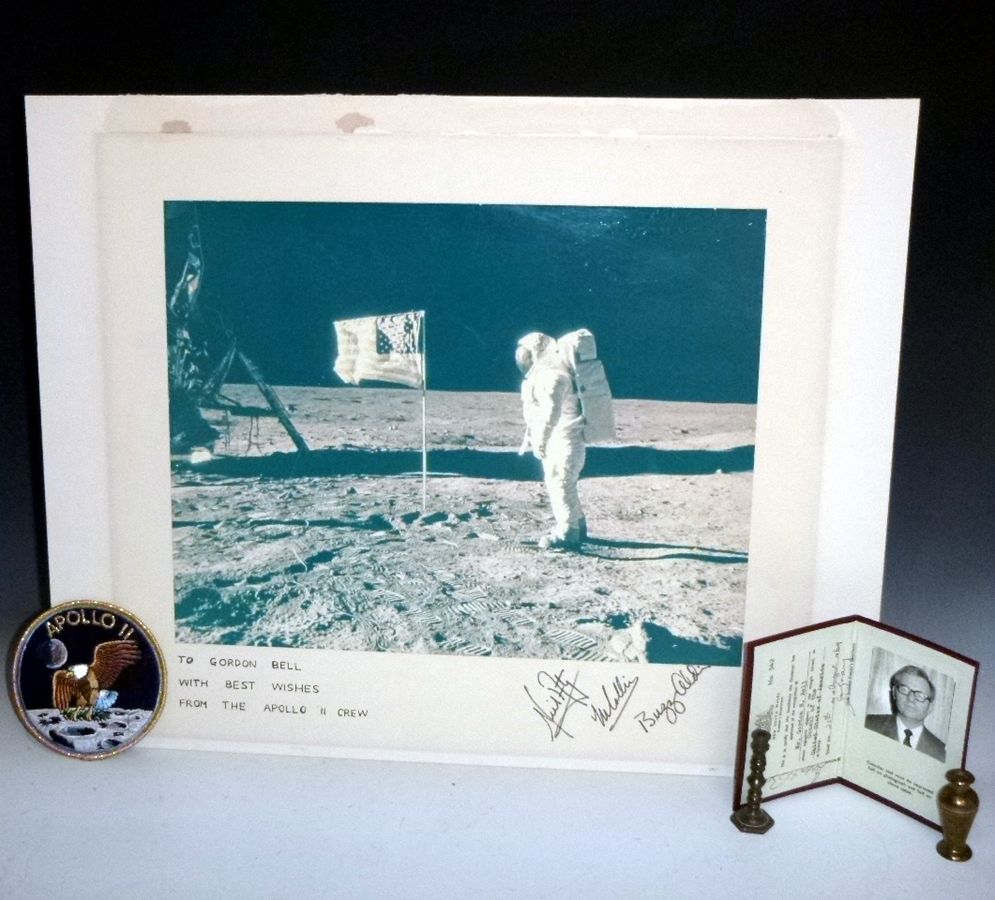
Approx.11" x 13 1/2" Mounted on 16" x 20 1/2" Card. When Gordon Bell was appointed to serve as USIS Information officer in July 1969, little did he know he would be promoted a month later to become U.S. Consul and would host the three astronauts of Apollo 11. In appreciation, they presented him with this photograph and inscribed: To Gordon Bell with Best Wishes From the Apollo 11 Crew (each of whom have boldly signed their names). Also in this collection comes Consul Bell's official appointment book and the official Apollo 11 patch (The earliest patch was intricately woven later copies are less dramatic copies. unframed with some age toning.
Offered by Alcuin Books.
ADVENTURES OF HUCKLEBERRY FINN
Twain, Mark
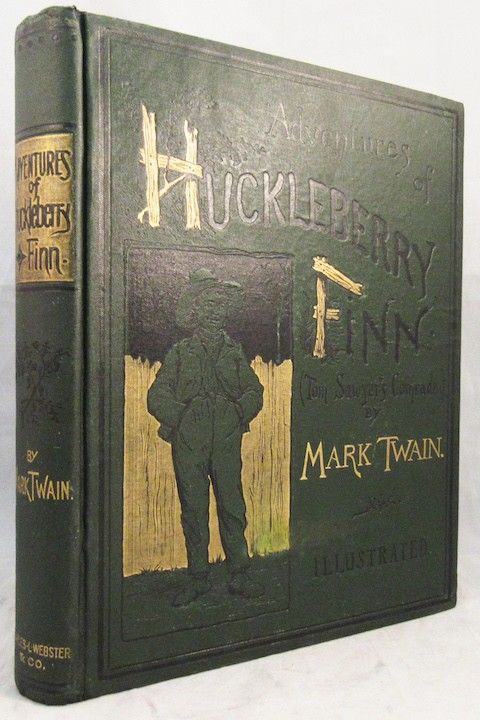
New York: Charles L. Webster and Company, 1885. FIRST AMERICAN EDITION, FIRST PRINTING with the very early issue points: "was" for "saw" on p.57; the Illustrations list p.[13] showing the "Him and another Man" plate as appearing on p.88; p. 9 with 'Decided' in the heading to Chapter VI, later corrected to 'Decides'; p. 155 with the final "5" dropped, the final leaf blank, no signature mark to p. 161. With 174 black and white illustrations by E.W. Kemble. Square 8vo, publisher's original green cloth elaborately decorated in gilt and black on the covers and spine, now housed in a custom slipcase with wraparound chemise. 366 pp. A handsome, well preserved and pleasing copy of this enduring classic. The cloth still nice and dark green with the gilt and black still strong on the upper cover, the giltwork on the spine well preserved, only very minor evidence of age or use to the tips and edges, the text-block very clean and the binding tight and firm. A fine survival of a cornerstone work, with some very skillful and near invisible sophistication, in collector's condition. THE FIRST EDITION OF ONE OF THE MOST IMPORTANT AND GREATEST BOOKS IN AMERICAN LITERATURE. "ALL MODERN AMERICAN LITERATURE COMES FROM ONE BOOK BY MARK TWAIN CALLED HUCKLEBERRY FINN"--Ernest Hemingway.
Along with TOM SAWYER, HUCKLEBERRY FINN is considered the stepping stone to modern American literature. And along with Tom Sawyer, for the first time, the hero of the novel was a boy. These books are landmarks and Hemingway often offered his opinion that the modern novel would have been impossible without them. With Whitman's LEAVES OF GRASS and Melville's MOBY DICK, they provide us with a view of America transcending its past and beginning its future.
Offered by Buddenbrooks.
Archive Related to Gladys Louise Husted Cromwell (1886-1919) and Dorothea Katharine Cromwell (1886-1919) Who Served as Nurses in WWI and Committed Suicide Together Just as Their Ship was leaving Port to Bring them Home after the War
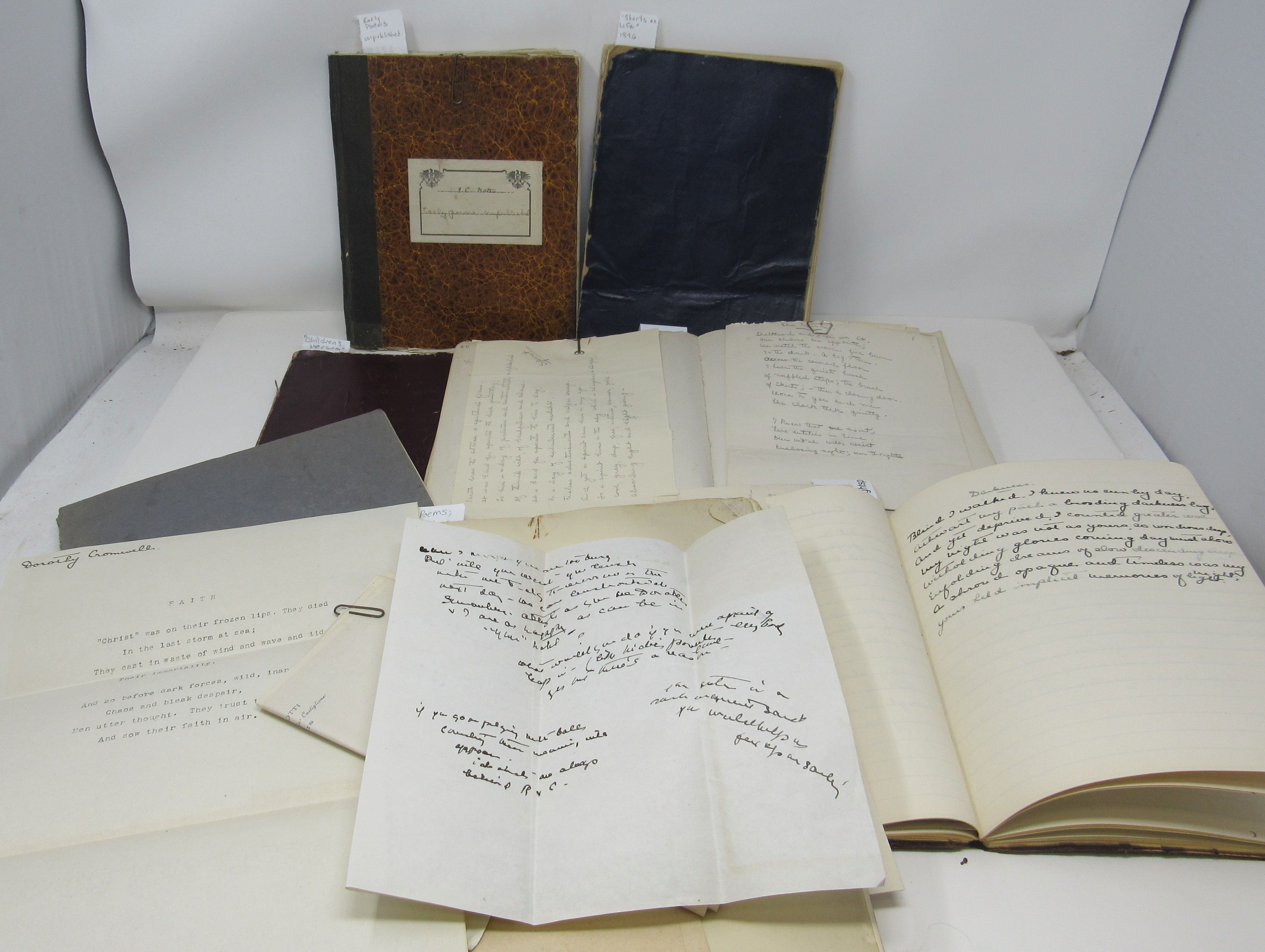
Gladys and Dorothea Cromwell were twin sisters, born November 28, 1886 into a life of wealth and privilege. Their Harvard-educated father, Frederic, gained his wealth from railroads and banking; he was the treasurer of the Mutual Life Insurance Company. Raised on a farm estate in New Jersey, the Cromwell sisters were educated at the prestigious Brearley School in New York City. As young women, they made several trips abroad, in 1914 travelling with (older) friends Anne Dunn and Katharine Burnett. When their father died in 1915 (their mother had passed in 1909), the sisters shared a considerable estate with an older brother (Seymour) and sister (Mary), inheriting almost half a million dollars each. By the 19-teens, the sisters shared an apartment on Park Avenue in Manhattan. With the outbreak of World War I, the Cromwell sisters volunteered with the Red Cross, serving as canteen workers and nurses' aides. They arrived in France in early 1918 and were stationed in Chalon-sur-Marne and Verdun. They served eight months, often in harsh and distressing conditions. Following the Armistice, they remained in France until January 1919. They boarded the S.S. Lorraine in Bordeaux; on the evening of January 19th, as the ship was underway, a sentry watched in horror as the sisters jumped overboard to their deaths. They were buried in France and received French military honors in recognition of their service. Evidence is scarce as to the reason behind the twins' suicide: period newspapers cite exhaustion and "derangement" from their wartime service and a feeling that their work had been in vain, anecdotal sources suggest they resisted their older brother's demand that they return from France.
Gladys Cromwell was a writer and poet. When she began to publish her work in the 19-teens, anecdotal sources suggest her family was unsupportive of such a public display. Following Cromwell's death, her friend and travelling companion, Anne Dunn, an English teacher, secured a contract with MacMillan to publish a volume of her poetry, entitled Poems. Sales were slow, but the volume received the Poetry Society of America award in 1920.
This collection includes six of Cromwell's notebooks of manuscript poems, including a volume of "Children's Verse," written while quite young; loose typescript and manuscript short stories; and notes on poems and revisions. There are four letters from Gladys and Dorothea to Dunn and Burnett, written from France, and an undated envelope with a note from Gladys to Dunn with directions on what to do with her papers should "anything happen" while serving abroad (she directed Dunn to destroy most of her work). The Cromwells' Wills detail the disposition of the estate. Additional legal documents relate to the bequests received by Dunn and Burnett. One notebook contains clippings and telegrams related to the suicide; additional newspaper clippings are in the collection. Correspondence regarding the contract, publication, publicity, and sales of Poems includes early reviews sent from a clipping service. A collection of postcards from Dunn to her family documents a 1914 trip to France and the U.K. taken with Burnett and the Cromwell sisters. Two photo postcards capture the travelers on the ship on the way to Europe. Two additional snapshots picture the Cromwell sisters: one in civilian clothes (date and location unknown) and in their Red Cross uniforms in France. Miscellaneous papers include notes on poetry and transcribed and typed letters from a nurse serving in Constantinople in the 1920s.
Offered by DeWolfe & Wood.
THE MALTESE FALCON
Hammett, Dashiell
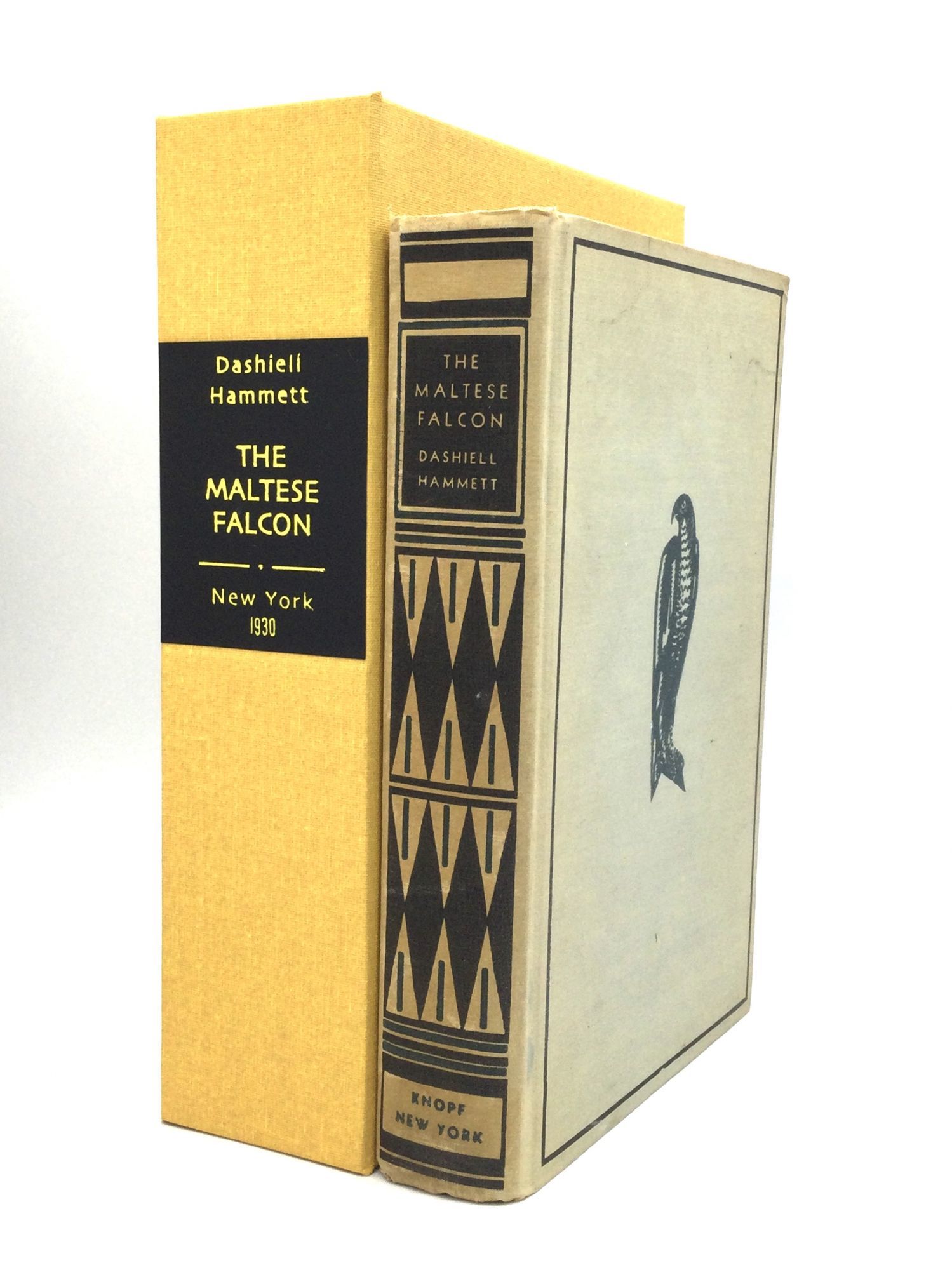
New York: Alfred A. Knopf, 1930. Hardcover. Very good. Fourth printing (June, 1930). Inscribed by Dashiell Hammett on the half-title: "To Joyce, in memoriam, September 12, 1930, Dashiell Hammett, Hollywood". The period bookplate of Joyce Newland Fluhr appears on the front pastedown. The best known of Hammett's Sam Spade books, regarded as both a cornerstone of the hardboiled detective genre and one of the greatest English-language novels of the 20th century. First published in February, 1930, it served as the basis for the 1941 film noir starring Humphrey Bogart and Mary Astor. Octavo. Original cloth binding, with black and gray stamping. Period bookseller's label from the legendary Satyr Book Shop, a favorite haunt of Hammett's during his time in Hollywood, to the rear pastedown. The spine is moderately toned, with a bit of mild wear to the corners and tips; else very good. Housed in a custom clamshell box.
Offered by johnson rare books & archives.
The Handmaid's Tale
Atwood, Margaret
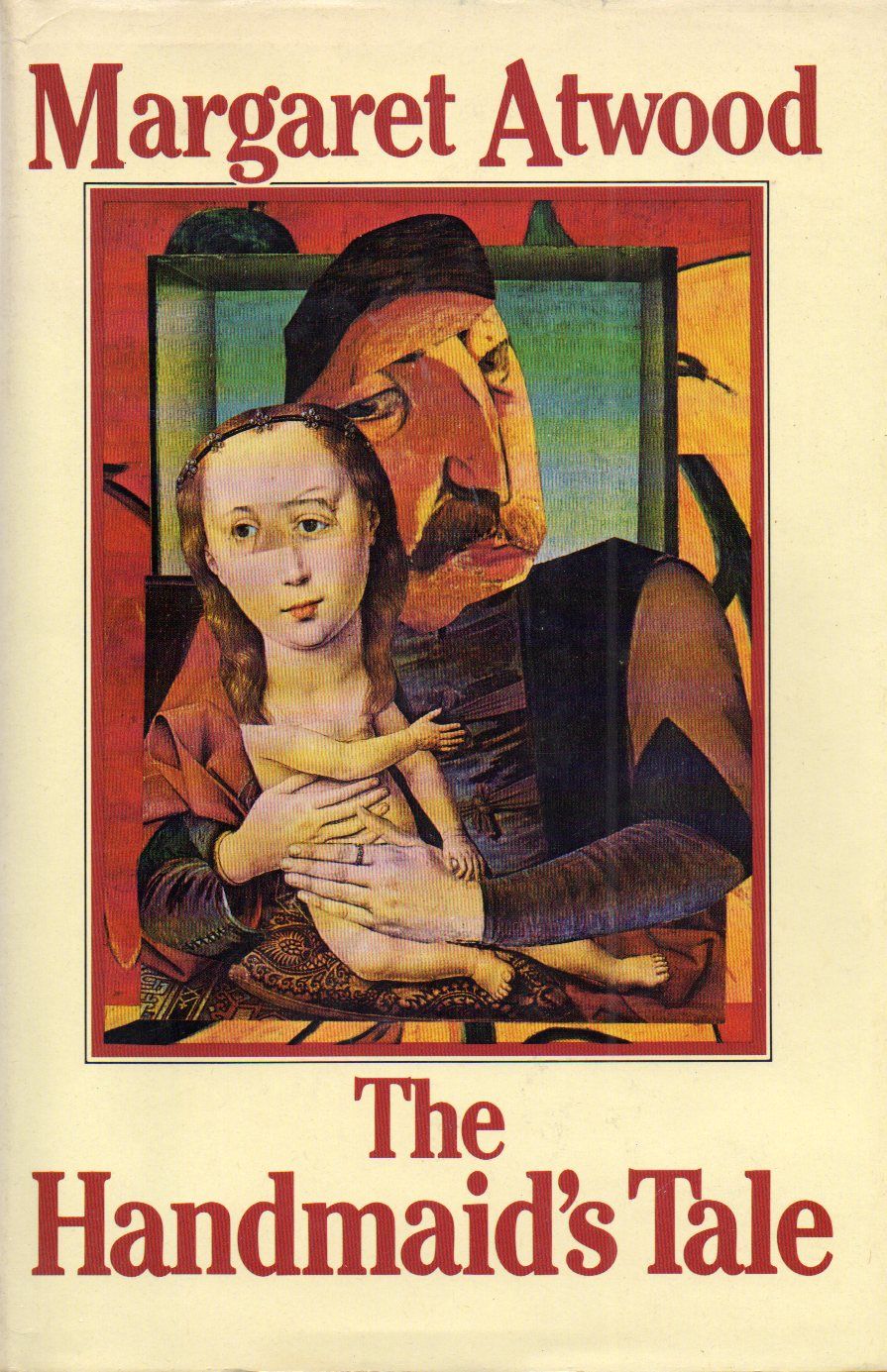
McClelland & Stewart, 1985. First Canadian (and true first) Edition (first printing). The sixth novel by the author of THE BLIND ASSASSIN and THE TESTAMENTS, a story set in what was once the United States in the near future where there are bizarre consequences for women. Shortlisted for the Booker Prize in Britain and basis for the award-winning Hulu television series. Near Fine/Near Fine -- light crimping at the head of the dust jacket spine and a small brown spot at the bottom edge of the pages, else a bright, clean copy. Signed by Atwood on the title page. Signed by Author. 1st Edition. Hardcover. Near Fine/Dust Jacket Included.
Offered by Bill Leone, Bookseller.
Jurassic Park
Michael Crichton
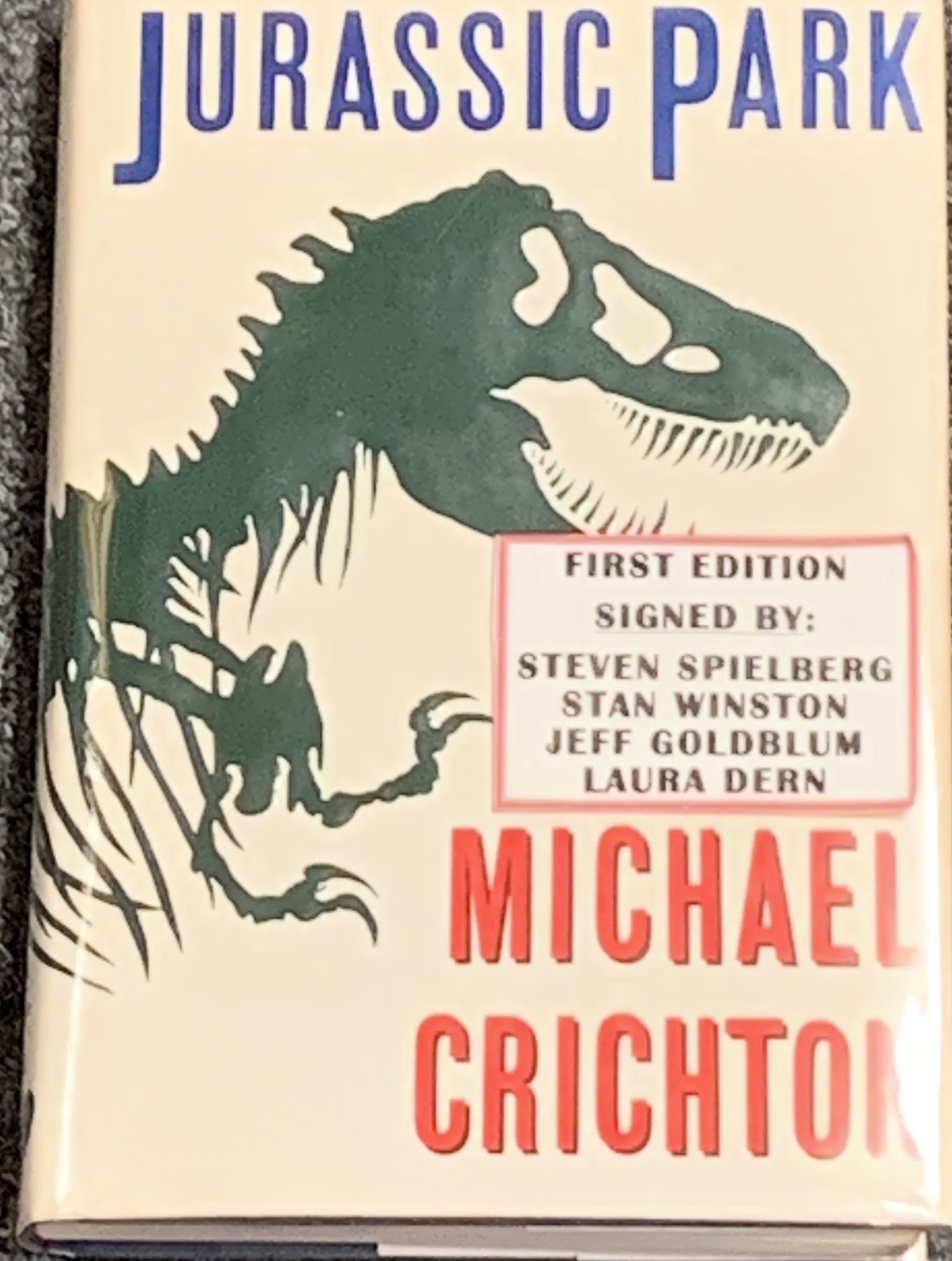
An extraordinary signed copy. This First Edition, First State copy of this now-iconic title would certainly qualify as very near Fine but for extensive foxing to top edge and foredge leaves, and a slight separation at spine crown. The original dust jacket is absolutely Fine.
What makes this unique copy so extraordinarily collectible is that on the title page it is boldly (and highly legibly) signed by STEVEN SPIELBERG, JEFF GOLDBLUM, LAURA DERN and the late, great STAN WINSTON. A Knopf publishers card SIGNED BY MICHAEL CRICHTON is laid in.
Offered by Mystery Pier Books.
(DOVES PRESS). (VELLUM PRINTING). SEVEN POEMS & TWO TRANSLATIONS
TENNYSON, ALFRED, LORD
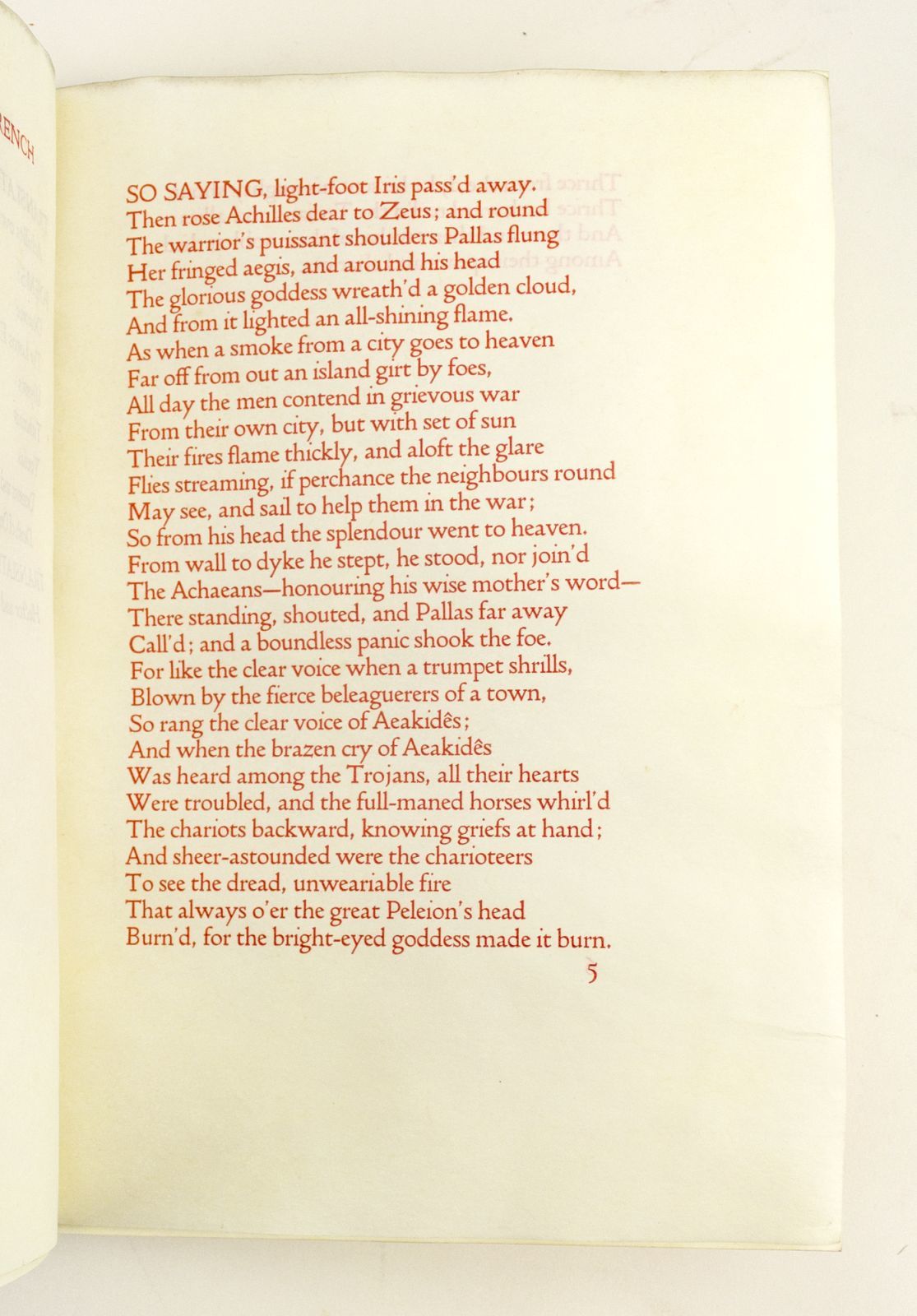
Boards a little wavy, minor (naturally occurring) variations in the grain of the covers, but a fine copy, the vellum leaves smooth, creamy, and bright, and the binding with few signs of wear.
This is the luminous vellum printing of the fourth publication of the Doves Press, gathering a number of poems by Tennyson written at various times in his long life, all of them reflecting his abiding interest in Homer and Greek myth. In contrast to Kelmscott Press founder William Morris' proclivity toward the Baroque, Thomas J. Cobden-Sanderson, the Doves Press founder (along with Emery Walker), demonstrated that printing with plain type (designed by Walker) that is well set and with good margins could produce notable work. As Cave says, the Doves Press books, "completely without ornament or illustration, . . . depended for their beauty almost entirely on the clarity of the type, the excellence of the layout, and the perfection of the presswork." For Cobden-Sanderson, who took up printing late in life, the elegant simplicity of the Doves books was intended to be in harmony with the works of God in creating the beauty and mystery of the universe. Nowhere does the simple splendor of Walker's typography appear to more perfection than in the sought-after vellum printings of Doves books. As with all other aspects of production, Cobden-Sanderson was fastidious about the quality of the vellum used, as can be seen in the bright, buttery-soft leaves here.
The selections in this volume are framed by two short translations of passages from Homer's "Iliad," both featuring images of fire and, appropriately, printed in red. Two other poems concern the tragic figure of Oenone, the first love of Paris; two are inspired by the "Odyssey"; and the other three treat, in turn, the figure of the Theban seer Tiresias; Tithonus, lover of the goddess of Dawn; and the myth of the theft of Persephone by Death. This copy was originally in the collection of famed book collector Charles Stephen Ascherson (1877-1945), a British shipowner of Jewish-German heritage who was the father of noted British actress Renée Asherson and grandfather of journalist Neal Ascherson.
Offered by Phillip J. Pirages Fine Books & Medieval Manuscripts.
Signed block print from Gods' Man
Ward, Lynd
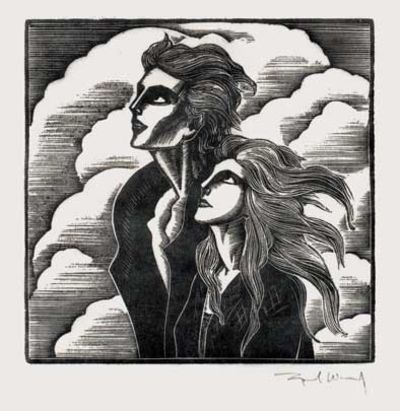
[New York]: [Jonathan Cape & Harrison Smith], 1929. A signed block print of one of the images from 'Gods' Man'. The printed on Japanese, the image measures 10 cm x 10 cm (same as the book). Signed in pencil by Ward under the image in the right corner. The image (no.116) is of the nameless artist and his wife looking skyward. The image is in fine condition. Presumably printed in a miniscule print run as a keepsake from the author and publisher. Gods' Man was the first of Ward's six wordless novels.
Offered by Ken Sanders Rare Books.
Anthem (Presentation Copy)
Rand, Ayn
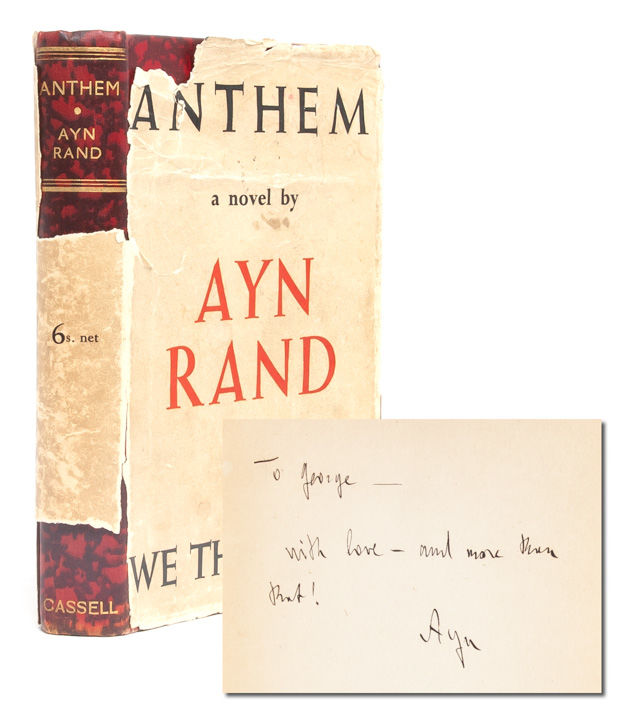
London: Cassell, 1938. First edition. Very Good +/Fair. Publisher's binding with red marbled boards and gilt to spine. Spine slightly cocked with rubbing to corners and base of boards. Black topstain and black endpapers. Scarce original jacket Fair only with significant paper loss to the spine and chips at the corners. Playfully inscribed "To George with love -- and more than that! Ayn. Jan 18, 1940." This copy last sold at Bonhams 2005 for almost $11,750.
"In the summer of 1937, Rand took a break from working on The Fountainhead to write the novelette Anthem, a short, highly stylized tale of a future dystopia so saturated in collectivism that the word 'I' has disappeared from the language...Anthem is Rand's 'hymn to man's ego.' It is the story of one man's rebellion against a totalitarian society. Equality 7-2521 is a young man who yearns to understand 'the Science of Things,' but he lives in a bleak, dystopian future where independent thought is a crime, and where science and technology have regressed to primitive levels...In pursuit of knowledge, Equality 7-2521 struggles to answer the questions that burn within him -- questions that ultimately lead him to uncover the mystery behind his society's downfall and to find the key to a future of freedom and progress" (Rand Institute).
Bonhams lot 3169 (2005). Provenance: From the private collection of Jay T. Snider. Very Good + in Fair dust jacket.
Offered by Whitmore Rare Books.
Declaration of Rights of the Women of the United States by the National Woman Suffrage Association
Anthony, Susan B., Lucretia Mott, Elizabeth Cady Stanton, et al
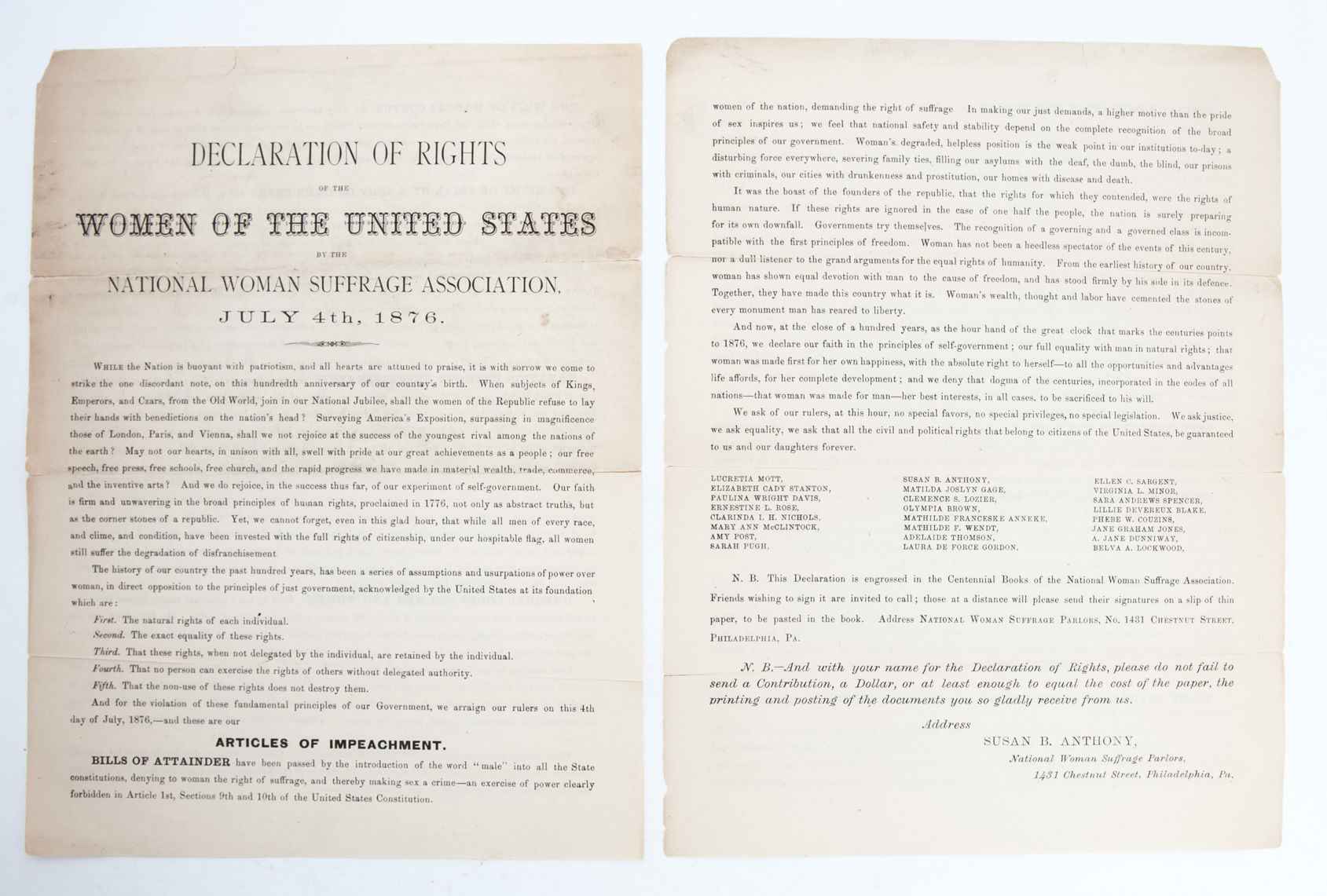
[Philadelphia]: [National Woman Suffrage Association], 1876. First edition. 4 pages. 11 x 8.5". Chipping at edges, minor cracking along folds, split into two pieces along central fold. Signed in type by women's rights trailblazers Susan B. Anthony, Elizabeth Cady Stanton, Lucretia Mott, Belva Lockwood and twenty additional suffrage leaders.
The Declaration exists in two nearly identical forms, printed under variant titles that are exceptionally rare in either form. This version, bearing the now famed title Declaration of Rights of Women of the United States is the only known copy to have come onto the public market according to auction records, with the remaining 11 examples held at research institutions. The only known surviving copy of the variant Declaration and Protest of the Women of the United States is held at the Library of Congress. While priority between the titles is unknown, the Library of Congress copy's omission of the second postscript and its four additional printed signatures suggest that it is the later of the two.
Elizabeth Cady Stanton and Susan B. Anthony's historic partnership began almost two decades prior to the Declaration, upon Stanton's urging that Anthony focus her activist efforts on women's property and citizenship rights. Together, they founded the National Woman Suffrage Association [NWSA], the most influential coalition promoting women's equality after the Civil War. Operating under the motto "Men, Their Rights and Nothing More - Women, Their Rights and Nothing Less," the NWSA spearheaded protests, petitions, and lobbying efforts to gain equal citizenship for American women. The 1876 Centennial International Exposition in Philadelphia provided a critical opportunity to highlight enduring inequalities between the sexes; and the Centennial committee's refusal to allow their presentation of the Declaration of Rights of Women at Independence Hall on July 4th fueled their determination. "Determined to have the final word, Anthony and four cohorts managed to obtain, at the last moment, passes for admission to the ceremony. At the conclusion of the reading of the Declaration of Independence, Anthony rose from her seat...climbed onto the stage, and presented to a bewildered presiding officer...the [Declaration of Rights of Woman]. The document was prepared and signed especially for the occasion by the most prominent advocates of woman's enfranchisement. After scattering hundreds of printed copies of the address throughout a curious crowd of onlookers, the women retreated from the hall. Outside...Anthony, before an enthusiastic crowd of listeners, read the famous Woman's Declaration" (Cordato).
The women's Declaration was unequivocal and powerful: "Now, at the close of a hundred years, as the hour hand of the great clock that marks the centuries points to 1876, we declare our faith in the principles of self government; our full equality with man in natural rights...and we deny the dogma of the centuries, incorporated in the codes of all nations—that woman was made for man... We ask justice, we ask equality, we ask that all the civil and political rights that belong to citizens of the United States, be guaranteed to us and our daughters, forever."
A pivotal founding document in the history of women's rights.
Offered by Whitmore Rare Books.
TROY. TAKEN FROM THE WEST BANK OF THE HUDSON, IN FRONT OF THE UNITED STATES ARSENAL
Bennett, William James

New York: Henry J. Megarey, 1838. Colored aquatint, image area 17¾ x 25½ inches. Mild toning. Very good. Matted and framed. Overall size: 28¼ x 35¼ inches. A wonderfully energetic and skillfully handcolored view of Troy, New York from across the Hudson River, produced by Henry J. Megarey, the publisher of THE HUDSON RIVER PORTFOLIO. The artist, William James Bennett, was a London-born watercolor painter and aquatint engraver, probably most famous for his 1841 view of New Orleans, one the finest depictions of American maritime commerce ever printed, and part of the same series of American city views as the current example.
Bennett's Troy view is striking in its own right. "In this beautiful aquatint of Troy by the artist, William James Bennett we see a well-developed and busy city. The white- columned building in the left center is the First Presbyterian Church, erected in 1835- 1836 (just in time to be included in the aquatint) and still standing today. The square tower with pinnacles to its right is Saint Paul's Protestant Episcopal Church, erected in 1827-1828 and also still standing....Making its way along the Hudson, further to the right, is the steam packet JOHN MASON, its deck, fore and aft, crowded with passengers. On the viewer's side of the Hudson, we are given a good idea of what well- dressed young men of the 1830s might be wearing....As is typical of Bennett's work, this view of Troy is a well-balanced pictorial image, containing elements of landscape and riverscape painting" - Deák.
Deák refers to Bennett's series of nineteen scenes of late 1830s to early 1840s urban America as "the finest collection of folio views of American cities." The present example is a first state copy, with the word "TROY" unshaded. Exceedingly rare. DEÃK, PICTURING AMERICA 479. STOKES, ICONOGRAPHY OF MANHATTAN ISLAND III, pp.619-22. STOKES & HASKELL, AMERICAN HISTORICAL PRINTS, P.1837-E-53, pp.83-84. FIELDING, AMERICAN ENGRAVERS 152. ENO 494.
Offered by William Reese Company.
"NOT A GERMAN CAME OUT OF THAT HOUSE ALIVE."
Corporal Herbert T. Wild
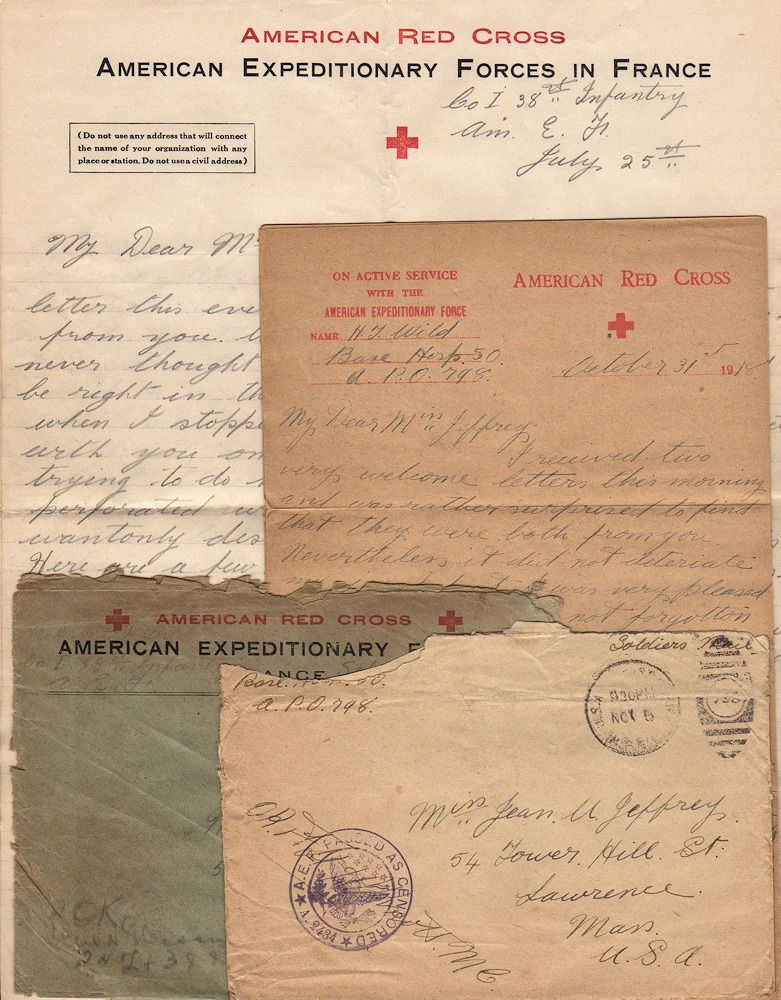
An amazing first-hand account by one soldier of heroism and bloody hand-to-hand fighting at the Marne River and in the Argonne Forest, two battles that turned the course of World War One.
Marne River and the Argonne Forest, 1918.
This grouping consists of two combat letters, a French Croix de Guerre, and one newspaper clipping. The earliest letter, dated July 25, consists of four pages and is enclosed in an envelope postmarked with an indistinct flag cancelation from APO 2 (Paris). The second letter, written from a Base Hospital and dated 31 October 1918, has seven pages and is enclosed in an envelope, dated November 5, from APO 798 (Meaves-sur-Loire). The Croix de Guerre has a bronze star affixed to its ribbon. The newspaper clipping recounts Wild's action at the 2nd Battle of the Marne. Everything is in very nice shape except the envelopes which are worn and have scrapbook paper remnants affixed to the reverse.
Wild enlisted in the Army in February 1918 and was assigned to the 3rd Division's 38th Infantry Regiment. On July 15, 1918, the German army launched a massive assault along the Marne River not far from Chateau-Thierry in an all-out effort to drive through Allied lines and capture Paris. The key crossing point was at the village of Mezy and the only thing that stood in the way was the 3rd Division's 38th Infantry.
"On July 15, 1918, the 38th Infantry . . . successfully defended its position on the Paris-Metz railroad, 200 yards from the River Marne, against six German attacks. It was the last great offensive of the German Army and the first fight of the 38th Infantry in World War I. Initially, the Germans succeeded in driving a wedge 4,000 yards deep into the 38th Infantry's front while the U.S. 30th Infantry on its left and the French 125th Division on its right withdrew under heavy pressure. With the situation desperate, the regiment stood and fought. The two flanks of the 38th Infantry moved toward the river, squeezing the German spearhead between them and exposing it to heavy shelling by the 3d Division artillery. The German Army's offensive failed. With this brave stand the 38th Infantry earned its nom de guerre Rock of the Marne. General John J. Pershing declared its stand 'one of the most brilliant pages in our military annals.'" (Stewarts's American Military History, Vol. 2, 2005)
On that day, during eight hours of intensive German bombardment, casualties in the 38th mounted, so with shells bursting around him, Wild volunteered to brave the shrapnel on foot and retrieve additional desperately needed stretchers and first aid supplies from caches in the rear. For this, he was personally recognized by General Pershing. As reported in the accompanying newspaper clipping:
"Corporal Wild was a 'runner' at the time he was cited. . . . The line had been a barrage of fire for eight hours and there were many wounded men. The little town of Connigis was the central target. Aid in the shape of stretchers and first aid men were sadly needed for the wounded men. Herbert Wild volunteered to go for it. He claims it was a strange sensation to be running through a town that was fairly crumbling about one's feet. The major to whom [he] reported declared that he did not know whether the officer who allowed him to come or the soldier himself was the bigger fool but Corporal Wild got what he went for and so was instrumental in saving a great many lives of the wounded men."
And . . . Wild modestly recounts the action in his letter of 25 July:
"I never thought I would get over here and be right in the midst of this terrible war. . . . The night of the fifteenth of July the Germans sent over the heaviest barrage fire ever known on the Western front. We were digging trenches . . . when Fritz opened fire and we crawled down in our trenches on the double. A continual bombardment was kept up for eight hours . . . but we pulled ourselves together and stood the test. . . . The Germans crossed the river Marne on pontoon bridges but were quickly driven back. . . . We were moved on to another sector [where] we drove the Germans back about three kilometers where we held the front line until we were relieved. . . . It was the greatest experience of my life. . . . Our regiment is going to have the Croix de Guerre attached to its colors for the bravery of the troops. We were highly praised by French officials of high ranks, but I am sorry to say that we lost good men in the battle."
Within days of saving Paris, the 38th was again thrust into battle along with other regiments of the 3rd, 28th, and 32nd Divisions. The Americans force-marched to Chateau Thierry in driving rain, many without food or sleep for two days. There at about 0430 on the morning of the 18th, the Americans led the Allied advance behind a rolling artillery barrage. The attack took the Germans by surprise; instead of typical trench warfare, the aggressive attack relied on direct charges, eventually driving the Germans from their positions. By the 22nd, the battle was over, and the will of the German army had been shattered. Although the war would continue for another four months, Chateau Thierry was its turning point. As German Chancellor Georg Hertling later noted, "We expected victory in Paris by the end of July. That was on the 15th. By the 18th we knew all was lost. The history of the world played out in three days."
In his second letter, Wild recounted bloodlust that overwhelmed him in the heat of battle:
"I have had some terrible experiences since I came over here. No one knows what the boys are going through. . . . We try to do our duty cheerfully even though it is gruesome at times. . . . My duty has been the cause of me killing three Germans that I know of. One I killed with my bayonet and two with a hand grenade. Of course you are shooting at them almost incessantly but we never know if we kill them unless you get near enough to use our bayonets and hand grenades. It is terrible to see the enemy so near that you see the blood lust in each other's eyes. I killed my Germans at Chateau Thierry. We were ordered to take a nest of machine guns that were situated in a shell torn house. I was put in charge of a squad of men and the Lieutenant attacked from one direction and I from another. We advanced . . . with bayonets fixed and in thrusting position. . . . We crept cautiously along the sides of the house and just as we reached the door a German walked right out . . . onto the point of my bayonet before he realized we were there. . . . [I pushed] my rifle forward giving him full benefit of the cold steel at the end of it. His blood poured out and down the stock of my rifle and onto my hand. It seemed to send me mad and just at that moment the Lieutenant gave the order to charge. We went into the house and threw hand grenades into every room, shutting the door before the grenades exploded and opening them after. . . . They did their work well. Too well for the Germans who had their machine guns trained . . . on Americans. . . . Not a German came out of that house alive."
At the time of listing, nothing anywhere similar to this is for sale in the trade, nor listed in OCLC; neither are there any remotely similar auction records listed at the Rare Book Hub.
Offered by Read'Em Again Books & Paper.
Opticks: or, a Treatise of the Reflexions, Refractions, Inflexions and Colours of Light. Also Two Treatises of the Species and Magnitude of Curvilinear Figures.
[Light/ Color Theory] NEWTON, Isaac
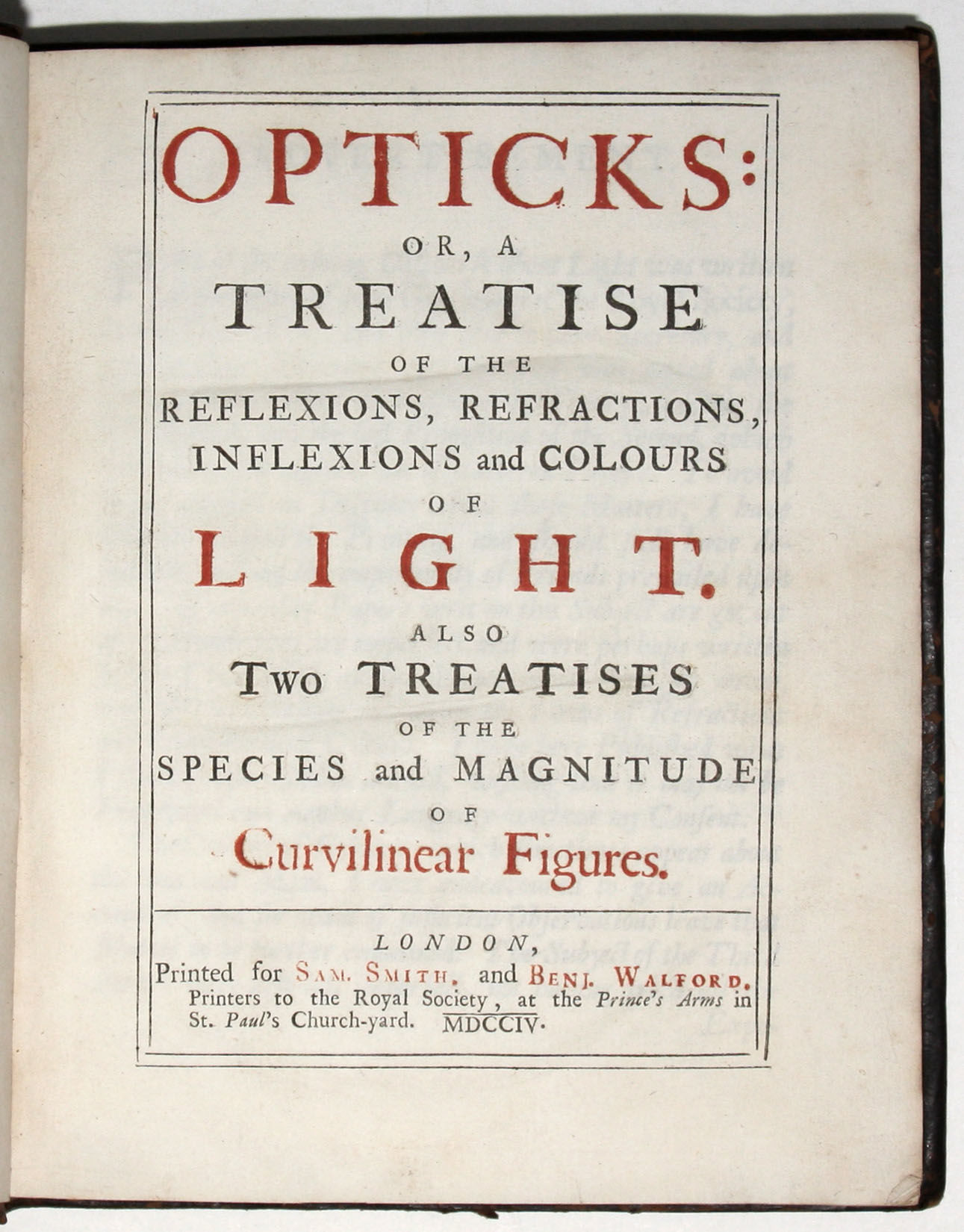
4to. [24.2 x 18.8 cm], (2) ff., 144 pp., 211 pp, (1) pp., with 19 folding engraved plates. Bound in contemporary English paneled calf. A fresh unrestored copy.
First edition, first issue of this landmark in science by Sir Isaac Newton (1642-1727), here in a remarkably well preserved, unrestored example.
"Isaac Newton began his study of light and optics while an undergraduate at Cambridge, and continued it at his Lincolnshire home during the plague years 1665-6 when (he recalled) 'I was in the prime of my age for invention'. Then, as today, the behavior of light was investigated experimentally and mathematically; Newton adopted both means, but the core of his work was the observation of the spectrum of colours (formed when a ray of light shines through a glass prism) is stretched along its axis, together with his experimental proof that rays of different colours are refracted to different extents. This causes the stretching, or dispersion of the spectrum.
"All previous philosophers and mathematicians had been sure that white light is pure and simple, regarding colours as modifications or qualifications of the white. Newton showed experimentally that the opposite is true: there are pure coloured rays which cannot be analysed by refraction, such as the green of the spectrum; just as there are coloured rays which can be analysed, such as the green formed by mixing blue and yellow light. Natural white light, far from being simple, is a compound of many pure elementary colours which can be separated and recompounded at will." – Printing and the Mind of Man 172.
A landmark book in the history of optics; and one of Newton's most important and influential works.
* Babson 132; Dibner 148; Horblit 79b; PMM 172; Norman 1588; Wallis 174.
Offered by George Robert Minkoff, Inc.
The Latin Ship of Fools – With Illustrations attributed to Albrecht Dürer: Stultifera navis. [Translated from German by Jacobus Locher Philomusus in collaboration with the author.]
Brant, Sebastian (1458-1521); Dürer, Albrecht (1471-1528), attributed artist. Locher, Jacob (1471-1528), translator
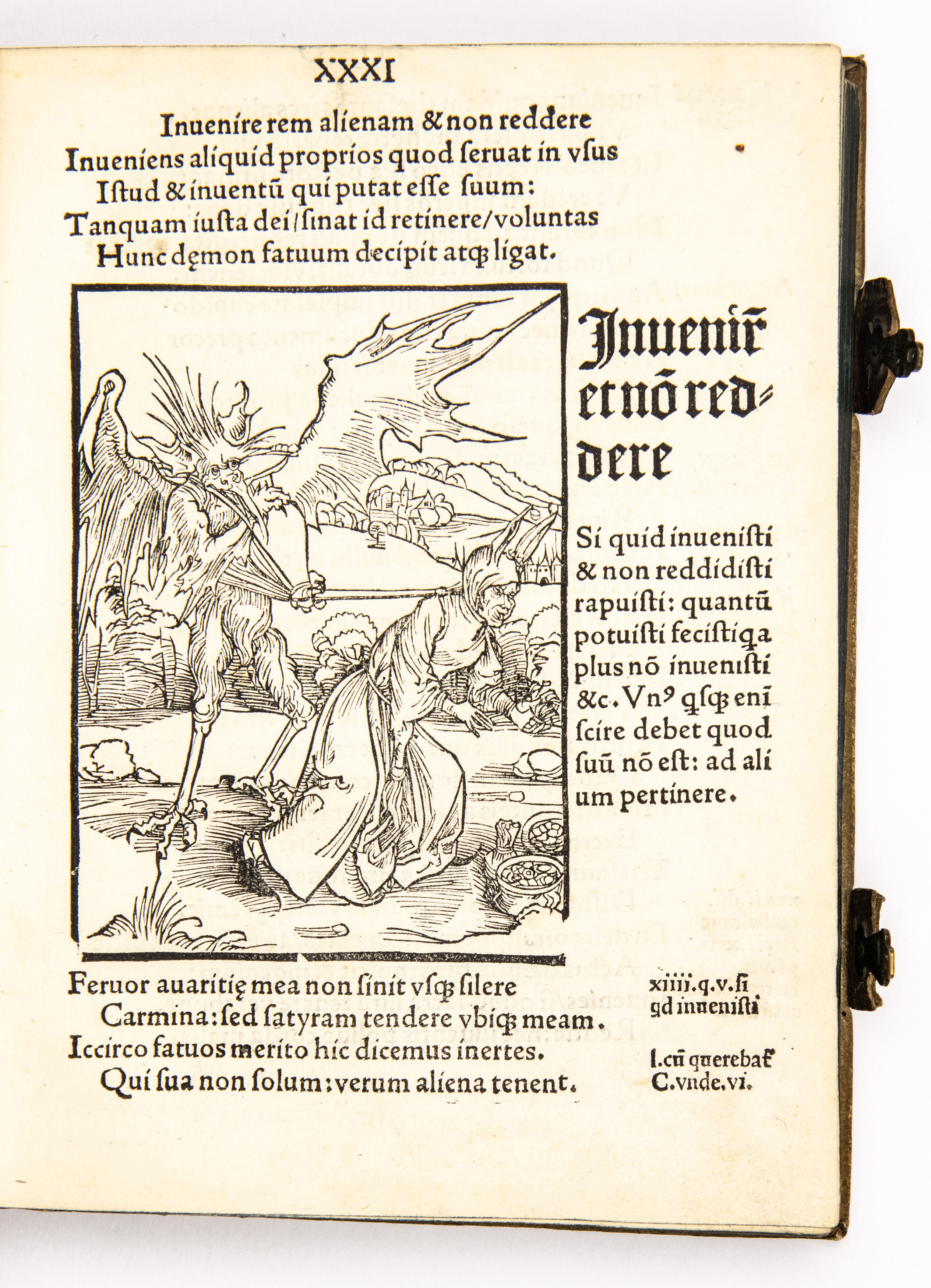
Chancery quarto: 20 x 14.8 cm. 163 leaves (of 164, without final blank). Foliation: CXLIIII, [4], CXLV- CLIX, [1, blank and lacking]). Collation: a-s8, [long s]4, t-y4 (-y4 blank).
SECOND ENLARGED LATIN EDITION.
Illustrated with the original woodcuts of the first German edition (1494), of which the majority (73) are often attributed to Albrecht Dürer. Bound in 18th c. blindstamped pigskin over wooden boards, soiled, clasps intact, edges minor repairs. A nice, unpressed copy with a small defect to the title woodcut, only affecting some of the fine lines in the water, which have been deftly restored in ink. Some folio numbers shaved in the upper margin, one leaf with loss to lower blank margin, closed interior tear affecting one leaf; occ. toning or light stains. Provenance: Edward Powell (18th c. armorial bookplate).
The text is illustrated with 120 woodcuts, two with decorative borders, often attributed to Albrecht Dürer, two eponymous artists (the Haintz Narr Meister, the Gnad-Her Meister) and perhaps several other artists. This edition includes additional woodcuts not present in the 1494 German original. The title page woodcut shows the fools in their ship. Bergman's ornate printer's device appears beneath the colophon.
Brant first published his "Narrenschiff" at Basel in 1494; a second, enlarged German edition appeared the following year and this served as the basis for the Latin translation by Jacob Locher, "Stultifera Naus", first published in 1497 (the year in which Locher was named poet laureate by Maximilian I.) Those publications were followed by this enlarged Latin edition, edited by Locher, expanded with additional poems by Brant and Thomas Beccadelli.
The attribution of the woodcuts to Dürer is still speculative. For arguments in favor of the attribution, see Winkler, Dürer und die Illustrationen zum Narrenschiff (1951); Lemmer, Die Holzschnitte zu Sebastian Brants Narrenschiff (1964), and R. Schoch, M. Mende, A. Scherbaum, eds, "Albrecht Dürer: das druckgraphische Werk", Bd. 3: 'Buchillustrationen' (München: 2004), pp. 86-127. For a recent critique of the attribution, see Peter Schmidt in "Der Frühe Dürer" (The Early Dürer), Germanisches Nationalmuseum, 24 May-2 September (exhibition catalogue, Nuremberg 2012.). Schramm attributes them to a "Meister der Bergmannschen Offizin", an anonymous artisan in Bergmann's print shop (Schramm, Vol. 22. p. 29, plates 147-177)
The book is also notable for containing the earliest literary reference to the discover of America: Hesperie occiduere rex Ferdinandus, in alto Aequore nunc gentes repperit innumeras" (leaf k4v.)
"The 'Ship of Fools' is the most important of a long line of moralizing works in which the weaknesses and vices of mankind are satirized as follies. The tradition goes back to early medieval times both in England and on the Continent (Lydgate's 'Order of Fooles and Wireker's 'Speculum stultorum'). It was the first original work by a German which passed into world literature... and helped to blaze the trail that leads from medieval allegory to modern satire, drama and the novel of character.
"In a ship laden with one hundred fools, steered by fools to the fools' paradise of Narragonia, Brant satirizes all the weakness, follies and vices of his time. Composed in popular humorous verse and illustrated by a remarkable series of woodcuts… the book was an immediate success. Brant's purpose was a moral one: he wanted to improve the life of his contemporaries and to help in the regeneration of the Holy Roman Empire and the Church. The follies of the clergy did not escape his censure… [In Brant's work, there is a foretaste of the movement of reformation.] Incidentally, the book also contains the earliest literary reference to the discovery of America; the Columbus Letter had been published by the same printer the year previously.
"The influence of 'The Ship of Fools' was extensive and prolonged: thirty-six editions were published between 1494 and 1513... Its most immediate imitators were Geiler von Kaisersberg, Thomas Murner, Hans Sachs and Johannes Fischart in Germany, where the 'Narr' as a type has lived until today. Erasmus's 'Moriae Encomium' was directly inspired by it."(PMM 37)
The book impressed Brant's learned contemporaries, including such diverse figures as Johannes Trithemius, who compared Brant to Dante and opined, "[Brant] should not have called his book a 'Ship of Fools' but rather a 'Divina Satira', and the humanist Jacob Wimpheling, who observed, "[Brant' has interspersed [his book] so adroitly with stories, fables, and the wisdom of the greatest masters that I do not believe you can find a comparable book in our language."
Brant's student and the translator of the "Ship", the poet Jacob Locher, linked Brant's work with the Roman satirists, Horace, Persius, and Juvenal. Badius Ascensius, who published Erasmus' "Praise of Folly" and wrote a work inspired by Brant, "the Ship of Foolish Women', stressed this same connection when he wrote, "[Brant] teaches and castigates the infatuated and the foolish who are infinite in number, with his witty and pleasantly readable argumentation, so that they are attracted by his sharp and humorous conversational tone and do not notice that they themselves are the butts of his satire, until he has already crept in on them and is playing with their innermost feelings [as Persius observed about Horace.] Thus he makes them regain their minds and forces them to accept the opinions of the wise, provided that there is any possibility of improvement in them.".
ISTC ib01091000; H 3751*; GW 5062; BSB-Ink B-821; Bod-inc B-513; Goff B-1091
Offered by Liber Antiquus.
The ABAA Virtual Book Fair: New York Edition takes place September 9-12, 2021 at www.abaa.org/vbf



